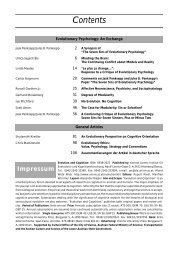Contents - Konrad Lorenz Institute
Contents - Konrad Lorenz Institute
Contents - Konrad Lorenz Institute
You also want an ePaper? Increase the reach of your titles
YUMPU automatically turns print PDFs into web optimized ePapers that Google loves.
Gestalt Experiments and Inductive Observations<br />
A peculiar feature of LORENZ’s epistemology is Gestalt<br />
perception, a cognitive process that is of paramount<br />
importance for the post-war defense of his<br />
approach. The notion of Gestalt perception is<br />
present in LORENZ’s early ethological writings, but as<br />
an epistemological idea explicitly formulated for<br />
the first time in early philosophical works such as<br />
the Russian Manuscript and defended throughout<br />
LORENZ’s philosophical, methodological, and biological<br />
writings (1943, 1948, 1950, 1958, 1959,<br />
1963a, 1963b, 1977, 1981). The most elaborated account<br />
is given in the article Gestalt perception as a<br />
source of scientific knowledge (1959). In Germany and<br />
Austria Gestalt psychology was an influential school<br />
before the second world war (ASH 1998), and so<br />
LORENZ could make use of ideas available from the<br />
German-speaking psychological tradition. In fact,<br />
as a student LORENZ took classes and interacted with<br />
the Vienna psychologist Karl BÜHLER and his assistant<br />
Egon BRUNSWIK, both of whom studied the psychology<br />
of perception. On LORENZ account, the distinctive<br />
feature of Gestalt perception is that it is a<br />
ratiomorphic process. LORENZ borrows this term in<br />
the post-war period from BRUNSWIK (1952, 1955),<br />
but the idea was present in BRUNSWIK’s post-war<br />
work even though he did not use this particular<br />
term for it (see BRUNSWIK 1934). Before using BRUN-<br />
SWIK’s term LORENZ makes reference to Hermann<br />
von HELMHOLTZ’s concept of unconscious inference<br />
(1948, p57; see HELMHOLTZ 1925, vol. 3.) Talking<br />
about ratiomorphic mechanisms means that we are<br />
dealing with a non-rational, subconscious process,<br />
that nonetheless exhibits strong analogies to rational<br />
thought—in particular induction—with respect<br />
to how it operates (1948, p55; 1959, pp296, 302;<br />
1981, p41). For LORENZ Gestalt perception as a special<br />
kind of perception is obviously a neurophysiological<br />
mechanism. LORENZ uses form constancy as<br />
an example to illustrate a simple type of Gestalt perception<br />
(1959, pp302f). When an observer sees an<br />
object from different sides (e.g., because the object<br />
moves and turns), the object is recognized as the<br />
same entity with the same form even though the<br />
image on the retina changes continuously. The human<br />
perceptual apparatus is able to extract from the<br />
different sensory data the relevant information that<br />
makes one see the same object at different instances.<br />
This process obviously works unconsciously.<br />
The individual is not aware of the steps<br />
taken by the nervous system to process information;<br />
only the result (e.g., the recognition of the object)<br />
is mediated to consciousness (1959, p296;<br />
1981, p43). Nonetheless, this subconscious mechanism<br />
exhibits analogies to reasoning (1959, p302;<br />
1981, pp42f). The process starts by using incoming<br />
data as ‘evidential basis’, it draws ‘inferences’ from<br />
this data and comes to a ‘conclusion’. As this procedure<br />
must make certain implicit ‘assumptions’ as to<br />
how objects in the external world behave, this kind<br />
of perception can be fooled by experimentally creating<br />
a situation that is unlikely to occur under normal<br />
conditions and violates these ‘assumptions’<br />
(1959, pp297ff; 1981, p41). In the preceding description<br />
of a ratiomorphic process the use of terms<br />
refering to rational thought in scare quotes indicates<br />
the analogy with rational cognitive processes.<br />
The ratiomorphic cognitive apparatus—which is<br />
evolved—has built-in ‘assumptions’ and ‘hypotheses’<br />
about how the external world looks like. As<br />
LORENZ assumes that Gestalt perception is important<br />
for hypothesis-free observation, these built-in<br />
implicit ‘hypotheses’ need to be kept apart from the<br />
hypothesis that a scientists consciously entertains.<br />
Both in rational and ratiomorphic mechanisms the<br />
reliability of the inference is proportional to the<br />
broadness of the inductive basis (1959, p315).<br />
LORENZ repeatedly mentions that Gestalt perception<br />
is analogous to rational thought in that it makes inferences<br />
and conclusions, albeit in an unconscious<br />
manner (1948, pp57, 59; 1958, p253; 1959, p283).<br />
His discussion of constancy mechanisms shows that<br />
the kind of inference that is made is similar to rational<br />
abstraction, which is an important part of induction<br />
(see also 1958, p252). Form constancy is a<br />
mechanism of pattern recognition; from various<br />
bits of incoming stimuli the features enabling the<br />
recognition of objects are mediated. At a few places<br />
LORENZ explicitly states that Gestalt perception is<br />
analogous to rational abstraction (1951, p173;<br />
1958, p252; 1959, pp283, 304).<br />
Form constancy is a simple example of Gestalt<br />
perception, but there are more complicated types of<br />
it. Gestalt perception is able to extract similarities<br />
and regularities out of data sets consisting of miscellaneous<br />
items. For instance, it is able to recognize<br />
objects and individuals given by perceptual information.<br />
Moreover, it can detect natural kinds and<br />
categories that exists in nature. By means of Gestalt<br />
perception different individuals are perceived to belong<br />
to the same species, genus, or family (1959,<br />
pp306f). Gestalt perception is an important tool in<br />
systematics. This is of fundamental importance for<br />
LORENZ because he views biological features as taxonomic<br />
characters that can be homologized. Ethology<br />
as a comparative-phylogenetic approach to behavior<br />
can makes fruitful use of Gestalt perception.<br />
Evolution and Cognition ❘ 161 ❘ 2003, Vol. 9, No. 2








